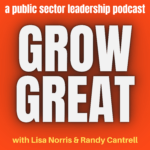Podcast: Play in new window | Download (Duration: 11:50 — 11.3MB)
Subscribe: Apple Podcasts | Spotify | RSS | More

Yesterday’s show was about our ongoing desire for more. And better. Today, let’s flip that idea on its head and talk about why less might make us happier. No, I’m not contradicting myself. Less is a path we should likely embrace more fully.
I’m a broken record in urging people to stop cheerleading that old trite maxim, “Everything is important.” It’s a lie. It presupposes that there are no priorities, which we all know is a lie. Some things are more important than others.
If everything is important, then nothing is important.
Truth is, some things matter a lot. Other things don’t matter at all. And a ton of things fall somewhere in between.
But when it comes to thinking about the magic of LESS, we can apply it to priorities, processes and most anything else. Let’s think together about just a few areas where less might make us happier, and more effective as leaders.
The To-Do-List
I don’t use them. Never have. I’ve always prioritized on the fly, in real-time. I’m skilled at it because I’ve done it my entire life. I’m constantly adjusting things, measuring the urgency and importance. It looks like multi-tasking, but it’s really not. It’s just the opposite. It’s less.
With today’s technology, there are so many things that can be handled in a few seconds or minutes. Let me give you an example of some things that have recently hit what would have made a traditional to-do-list.
I do some volunteer work that has to do with my church work. A friend, and co-worker in the Faith who lives in Alabama – I’m in Dallas/Ft. Worth – was texting me late last Friday. We’ve got a Labor Day event here in DFW. I had an idea, asked him via text what he thought. He immediately texted me back, “That’d be great.” Within 5 minutes I had updated a website with the information and posted the same information on two different Facebook pages. Done.
Was it that important? Or urgent? No. But I was at my computer with all the tools I needed to execute it quickly, so I did.
It would have taken me at least a minute to log it onto a to-do-list. Took me 5 minutes to complete it without logging it anywhere.
And that’s how I operate. I’m not telling you how you should operate. I’m just telling you what has always worked for me. Yes, I’m practiced. Yes, I’m detail oriented. No, I’m not forgetful. To each his own.
For me, and I hope for you, we can get more done if we can limit the irons in our fire. We’ve all got a fire going. And we don’t lack for irons. Some irons represent problems. Others, opportunities.
Too many leaders feel the need to handle the irons. They dodge and perry, shooting quickly from one thing to another, to another. More, more, more.
We’ve all got too much data coming at us, and we’ve got too many irons in the fire to handle them all simultaneously. Let me encourage you to figure out how you can incorporate LESS into your life so you can actually get MORE done.
Push your attention and brain power onto one iron at a time. If an iron represents a problem, pick the one that needs fast attention (or it’ll get hotter). Pull it from the fire and get rid of it. Don’t put a bandage on it. Heal it. Forever, if possible. It may mean you do your part to heal it, then you pass it onto somebody else who can carry it the rest of the way. That’s great. Just get it done so you can forget about it.
If an iron represents an opportunity, look for the irons that are short-term opportunities where execution can happen right away without complex decisions. Sometimes it’s simply us saying “Yes” to something. Or “No” to something. Why leave an iron of opportunity in the fire waiting on a quick decision from you? Handle it now and let your company be taking advantage.
Complexity
Less is more. Work to squeeze the complexity out of your operation as much as possible.
Some things aren’t simple or easy. They’re difficult, complicated and ridiculously hard. But there are other things going on in our companies that are much more complex than necessary. Sometimes time has piled on the difficulties. I’ve gone into companies that had piles of procedures and systems that formed over time. So much so, that you’re hard pressed to find a single employee who knows why some of them exist. They got started, others got added, then others, and before you know it things are more cumbersome than necessary. I’ve seen it happen in every business. Complexity grows instead of effectiveness and efficiency.
One of the best solutions is to get out of your office and walk around. Tom Peters and Bob Waterman called it “managing by wandering around” in their 1982 class, In Search Of Excellence. Peters and Waterman found it happening at Hewlett Packard back in the 1970’s. One wonders if HP stopped doing it. Some historians say President Lincoln may have been the first to do it as he would walk around inspecting the Union troops, but I suspect ancient leaders centuries ago did it, too.
The point is to visit the source. Go where the work is happening. Talk with – and closely listen to – the people who are doing the work. They’re the people who can quickly (and happily) tell you where complexity exists. Complexity that makes no sense to them. Now it could be, there are things in play they’ve not considered. That’s fine. It gives you the opportunity to help them understand that there is a WHY to the thing they thought was senseless. Or, it could be that the thing is completely useless and just some layer that got added, which nobody gave a second thought.
It’s time to give complexity and your commitment to simplicity a second, third and fourth thought. Then take swift action. The troops will cheer. Customers will, too.
Meetings
They are the bane of every leader’s existence. The only people who like meetings are people who hate to work. It’s another rather universal area in business where less is often more.
I once had a client with a very meeting intensive culture. You could visit the top three layers of leadership and quickly discover that almost 70% of their collective time was spent in meetings. Quite often, as many of you will attest, meetings were scheduled that overlapped. A meeting might be scheduled to begin 10 minutes before a prior meeting was scheduled to conclude. When I’d ask, “What do you do?” leaders would report that sometimes they’d leave a meeting early or other times they’d be late to the next meeting. They were rather blase about the whole thing. It was as though it were no big deal. I soon found out why. The meetings felt like a waste of time, but they were unable to do anything to change it. Or so they thought.
Many of you know the feeling. While not every business has a culture quite so meeting-intensive, many of us have poorly run, poorly structured meetings. And too many of them, to boot. Less is more.
You own the joint so you can implement change. Or you’re a leader who can at least impose change on the meetings you’re in charge of. Do it. Today.
We’re stuck in thinking meetings have to be 30 minutes or an hour. Wrong. Make them as long as they need to be, but no longer. Sometimes 7 minutes is just right. And if you feel stupid scheduling a 7-minute meeting, let me challenge you to do it. Along with sharing the structured agenda for the meeting and the notice that they’ll be a hard start and hard stop. See how much better it goes. Besides, everybody will be wondering, “Why 7 minutes?” You’re opening line might be, “Because I expect us to get this done in 7 minutes or less!”
Time is a constraint for all of us. This isn’t about you acting like your time is so much valuable than everybody else. It’s about valuing EVERYBODY’S TIME. It’s about being respectful. And it’s about getting on with it so actual work – real, meaningful action – can take place.
Don’t try to make a single meeting do too much. This is a common problem. We think we have to squeeze every possible agenda item into a single meeting. Instead, think about having shorter, more specific (targeted) meetings only with the people who really need to be in the room. Give the meeting one objective – again, less is more.
Conclusion
These are just a few examples to get you started. Think about all the areas of your operation where “less is more” might profit you. Look hard enough and you’ll likely find them just about everywhere you look.
“That’s been one of my mantras – focus and simplicity. Simple can be harder than complex: You have to work hard to get your thinking clean to make it simple. But it’s worth it in the end because once you get there, you can move mountains.” -Steve Jobs
“I do believe in simplicity. It is astonishing as well as sad, how many trivial affairs even the wisest thinks he must attend to in a day; how singular an affair he thinks he must omit. When the mathematician would solve a difficult problem, he first frees the equation of all incumbrances and reduces it to its simplest terms. So simplify the problem of life, distinguish the necessary and the real. Probe the earth to see where your main roots run. ” ? Henry David Thoreau
Be well. Do good. Grow great!

Listen to the podcast
 About the hosts: Randy Cantrell brings over 4 decades of experience as a business leader and organization builder. Lisa Norris brings almost 3 decades of experience in HR and all things "people." Their shared passion for leadership and developing high-performing cultures provoked them to focus the Grow Great podcast on city government leadership.
About the hosts: Randy Cantrell brings over 4 decades of experience as a business leader and organization builder. Lisa Norris brings almost 3 decades of experience in HR and all things "people." Their shared passion for leadership and developing high-performing cultures provoked them to focus the Grow Great podcast on city government leadership.
The work is about achieving unprecedented success through accelerated learning in helping leaders and executives "figure it out."

